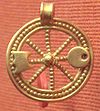Atepomarus
This article needs additional citations for verification. (August 2021) |
Atepomarus[1] or Atepomaros[2] in Celtic Gaul was a healing god from Mauvières (Indre). Apollo was associated with this god in the form Apollo Atepomarus.
At some of Apollo's healing sanctuaries (as at Sainte-Sabine, Burgundy) small figurines of horses were associated with him.
Names and etymology
[edit]The title also appears as Atepomerus.[3]
Scholarship suggests the name is a compound of at- (intensifier), -epo- (the Celtic word for "horse") and -marus ("large, great").[4][5] Thus, the epithet is sometimes translated as "Great Horseman"[6][7] or "possessing a great horse".[8][9]
Pierre-Yves Lambert rejects his connection with horses and suggests an etymology based on *ad-tepo, related to 'protection, refuge'.[10]
Role
[edit]As founder
[edit]A character named Atepomarus appears with a Momoros (fr) as a pair of Celtic kings and founders of Lugdunum. They escape from Sereroneus and arrive at a hill. Momorus, who had skills in augury, sees a murder of crows and names the hill Lougodunum, after the crows. This myth is reported in the works of Klitophon of Rhodes and in Pseudo-Plutarch's De fluviis.[11][4][12][8]
As a theonym
[edit]The name appears as a theonym attached to Graeco-Roman deities Apollo and Mercurius.[8][13] An inscription of Apollo Atepomarus was found in Mauvières, tied to the Gallic tribe of the Bituriges.[14][15]
References
[edit]- ^ Jacques Lacroix (2007). Les noms d'origine gauloise - La Gaule des dieux (in French). Errance. p. 102. ISBN 978-2-87772-349-7.
- ^ Lacroix, Jacques (2012). Les noms d'origine gauloise: La Gaule Des Combats (in French). Éditions Errance. p. 184. ISBN 978-2-87772-479-1.
- ^ Persigout, Jean-Paul (1996). Dictionnaire de Mythologie Celte (in French). Éditions du Rocher. p. 103. ISBN 2-268-00968-8.
- ^ a b Bousquet, Jean (1971). "Inscriptions de Rennes". Gallia (in French). 29 (1): 109–122 [116: footnote 15]. doi:10.3406/galia.1971.2572.
- ^ Matasovic, Ranko (2008). Etymological Dictionary of Proto Celtic. Brill. p. 258. ISBN 978-90-04-17336-1.
- ^ Jacques Lacroix (2007). Les noms d'origine gauloise - La Gaule des dieux (in French). Errance. p. 102. ISBN 978-2-87772-349-7.
On trouve aussi dans les inscriptions un théonyme ATEPOMARUS, le «Grand-Cavalier» (surnom de l'Apollon ou du Mercure gaulois) ...
[We also find among the inscriptions a theonym ATEPOMARUS, the "Great Horseman" (epithet to the Gaulish Apollo or the Gaulish Mercury) ...] - ^ Lacroix, Jacques (2012). Les noms d'origine gauloise: La Gaule Des Combats (in French). Éditions Errance. p. 184. ISBN 978-2-87772-479-1.
... ATÉPOMAROS (le "Très-grand-Cavalier") ...
- ^ a b c Gricourt, Daniel; Hollard, Dominique (2002). "Lugus et le cheval". Dialogues d'histoire ancienne (in French). 28 (2): 121–166 [124, 126]. doi:10.3406/dha.2002.2475.
- ^ Polomé, Edgar C. "Etymologische Anmerkungen zu keltischen Götternamen". In: Zeitschrift für celtische Philologie (ZcP) 49-50, no. 1 (1997): 741. https://doi.org/10.1515/zcph.1997.49-50.1.737
- ^ Lambert, Pierre-Yves (2012). "Patrice Lajoye, Des dieux gaulois. Petits essais de mythologie. Budapest, Archaeolingua alapítvány, Series Minor no 26, 2008". [Review]. Études Celtiques (in French). 38: 320–321 [321].
- ^ Johnston, Andrew C. (2017). The Sons of Remus: Identity in Roman Gaul and Spain. Harvard University Press. pp. 142, 144. ISBN 9780674660106.
- ^ Clavel-Lévêque, Monique (1985). "Mais où sont les druides d'antan... ? Tradition religieuse et identité culturelle en Gaule". Dialogues d'histoire ancienne (in French). 11: 556–604 [598]. doi:10.3406/dha.1985.1675.
- ^ Carru, Dominique; Christol, Michel; Janon, Michel (2004). "Mercure et les Ateii de Carpentorate (Carpentras, Vaucluse): Note sur une inscription récemment découverte". Revue archéologique de Narbonnaise (in French). 37 (1): 277–289 [285]. doi:10.3406/ran.2004.1143.
- ^ Hatt, Jean-Jacques (1983). "Apollon guérisseur en Gaule: Ses origines, son caractère, les divinités qui lui sont associées - Chapitre II". Revue archéologique du Centre de la France (in French). 22 (3): 185–218 [189]. doi:10.3406/racf.1983.2383.
- ^ Fincker, Myriam; Tassaux, Francis (1992). "Les grands sanctuaires "ruraux" d'Aquitaine et le culte impérial". Mélanges de l'École française de Rome: Antiquité (in French). 104 (1): 41–76 [71]. doi:10.3406/mefr.1992.1746.
Bibliography
[edit]- Dictionary of Celtic Myth and Legend. Miranda Green. Thames and Hudson Ltd. London. 1997
- Animals in Celtic Life and Myth, Miranda Green, Routledge.
Further reading
[edit]- Picard, Gilbert Charles (1977). "Imperator Caelestium". Gallia (in French). 35 (1): 89–113. doi:10.3406/galia.1977.1557.


